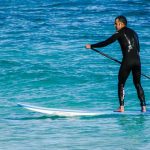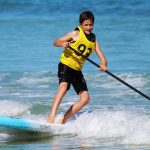Riding a stand-up paddleboard can provide numerous opportunities for aquatic fun and fitness. SUP boards can be employed for touring, competing, surfing, sailing down rivers, yoga, fishing, or simply paddling around and relishing the great outdoors.
The range of activities you can perform on a stand-up paddle-board is mirrored in the many shapes and dimensions of boards made for particular objectives.
A SUP board meant for racing or touring typically has an extended length, while those more suitable for navigating river rapids often have a larger width than normal, and those designed for surfing sea or river waves are usually shorter than the standard size.
The characteristics that make a paddle board ideal for a certain task can be restricting for different types of surfing.
A board with a large length will be tougher to maneuver, while one that is wide or narrow will lack the ability to glide efficiently, which will consequently make it move more slowly than other boards.
If you are new to the sport, it is advised that you experiment with different techniques, rather than sticking to one particular discipline.
People who are in search of their first paddle boards should be investigating the all-around type, as these are well-equipped to do multiple tasks satisfactorily, but not specialized in any one type of paddling.
Here are the questions you should ask yourself before buying an all-around inflatable paddle board:
Is The Board Shape Versatile Enough For All Kinds of Paddling?
It is essential to contemplate Length, Width, Thickness, and overall contour…
Length
Boards for middleweight paddlers are commonly between 9”6 and 11” long, providing sufficient length for speedy, efficient navigation and enough maneuverability for turning.
The boards that are most commonly seen in this category range between 10’6” and 10’9” in size, although the size a person chooses should depend on their height and weight.
Width and Thickness
A board size of around 32 inches is the ideal size for stability and agility, though the best size can range from 30 to 34 inches based on the body of the user and their paddleboard’s specifications. One must take into account the depth of the board when determining its width and length.
Many mass-produced boards tend to be 6 inches thick, however, a 5 inch board, which has been appropriately made, has a lowered center of gravity, providing more stability and easier access to hop back on after a tumble, and in general will allow for a more pleasurable paddle experience.
Many companies take a shortcut to building stable boards by using a six-inch thick design, but it is possible to construct a better, five-inch thick board with superior strength and more balance through proper production methods and material selection.
6-inch boards should not be the only option taken into consideration; the selection of board thickness should be based on the board’s performance requirements and should coincide with both the board width and design.
A surfboard 6 inches thick requires a width of 33 to 34 inches to help keep it stable as it has a higher center of gravity than usual, lest it feel unsteady.
Outline shape
A board created to be used in a variety of ways should not feature extreme shapes in its outline. The configuration of the tail has a major effect on the general appearance. A board that has a round tail or a flat tail with curved edges is the most effective and efficient in terms of its performance.
A board with a tail that is slim will feel less stable compared to boards that have more bulk in the back.
Be wary of paddle boards with very long and thin noses, since those can be troublesome if you want to ride with a kid or pet, or want to lie down for yoga or pleasure, but may not bring about extra speed in common use.
Producers may mold their boards in a way that reduces the expense of the materials used, which can cause the shape of the board to not be ideal for those riding it.
What Fin System Will Work Best For Me?
This is a matter of opinion and there are two possible approaches to selecting a fin system. If you would like to experience a hassle-free paddleboarding session, you should select a board equipped with permanent fins that can’t be damaged.
If you want to be more specific with your equipment, you can get a fin system that is adjustable, allowing you to change the fins to fit different paddling types or conditions.
A board fitted with a fin box in the center that is compatible with US standards and fin boxes that are FCS-compatible on the sides offers the opportunity to experiment with different fins for different activities and not be restricted to the fin set provided with the board.
You should stay away from removable center fins that are from a certain company because if it gets broken or lost, it will be tough to find a replacement and you won’t be able to adjust the fin depth to deal with changing paddling conditions.
The least expensive boards typically feature a removable brand name center fin and two considerably smaller side fins that are affixed permanently.
US Fin Box
For optimal use in a variety of scenarios, your board needs to have a center fin box that follows the common industry-wide specifications, opening up a wide range of possible fins that can be used on the board.
The US Fin Box, otherwise known as the US Box, is the most widely used fin on surfboards and thusly presents customers with a wide selection of fin alternatives. This specific fin has a lengthy tradition.
You will have the choice of, for example, putting on a smaller center fin in shallow water and then switching it to a longer fin for long paddles.
FCS Side Fins
Boards that include two fin receptacles can be adjusted further by adding fins of your selection. FCS is the most widely adopted compatibility standard for side fin boxes, for the same reason as why the US Box is popular.
It is straightforward to get FCS fins as they are compatible with surfboards and feature the same type of attachment tabs across the board.
Configurable vs Permanent Fin Setup
A permanent tri-fin system is a valid option when it comes to selecting a stand-up paddleboard, as it features three flexible and unbreakable fins of an equal size, usually about 4 inches high.
This option should be taken into account, although having a board that allows for a variety of centers and side fins is the ideal choice for greatest adaptability.
This is an excellent choice for school and rental fleets, since it lessens the chance of fin breakage, while simultaneously providing recreational paddlers with a set-up they won’t have to fiddle with or be concerned about losing or damaging removable fins.
A setup featuring three fins that are fixed in place will operate effectively in a wide variety of circumstances, although it won’t be quite as adaptable as a board with a configuration that can be changed more easily to suit different surfing scenarios.
The price of fins that can be changed on pricier boards can be avoided by choosing this option, so it all depends on your level of technical knowledge and how much you’re willing to put down for the board.
Does The Deck Pad Have The Features I Need?
The material and feel of the deck pad have a major influence on how the board feels when you stand on it, especially on longer trips. Generally speaking, having a wider, lengthier deck pad that covers more area of the board will elevate the enjoyment when riding it, as well as its capability to be used for activities such as yoga, stretching, and taking it easy out on the water.
Pay particular attention to the rear part of the deck pad. A board that has a tail pad area with a raised back edge is designed to stop your back foot from slipping off the board and to provide extra power when pushing your foot down.
A special element which a handful of boards have, although it is instrumental, is an arch bar. This is a slightly prominent extension at the back of the pad on the deck which makes it simpler for the rider to know where their back foot is without having to look down.
Rivets, known as arch bars, are a usual sight on surfboards, while a handful of inflatable SUP makers have started to include them on paddle boards.
The 4 Best Inflatable SUP Boards of 2023
Best Overall Inflatable SUP
Bluefin Cruise Carbon
Our preference when it comes to inflatable SUPs is the Bluefin Cruise Carbon, as it is built with a sturdier, reinforced-carbon framework and boasts remarkable all-around capabilities.
This kayak is 12 feet long and features a pointy nose which offers great movement in the water, as well as 32 inches of width and a carbon fiber Flex Reduction System (FRS) which maintains steadiness in choppy waters and offer a reliable paddling experience.
The Cruise Carbon is designed with a special feature that involves a kayak seat attachment and a detachable paddle, which allows the board to be maneuvered while seated in a fashion similar to kayaking.
We tried a lot of pumps and the dual-chamber one with a large capacity definitely stands out. Additionally, the durable bag that comes with it has small roller wheels and cushioned straps for comfort.
Apart from the mentioned traits, the object also possesses dual cargo binding systems, handles at both the front and rear, and a pre-installed kick-pad on the covering.
The Cruise Carbon 12 is the top choice when it comes to inflatable boards, in part due to the use of high-end materials in its manufacture and its predictably dependable performance.
Best High-Performance Buy
Bote Breeze Aero
Novice and intermediate kayakers will become more self-assured when using the Bote Breeze Aero, even when facing different conditions, owing to the board’s robustness and low weight.
Combining high-grade materials while preserving its lightness, the Bote is praised for both its performance and affordability. This model has a spacious trunk, a few handles, and D-rings located on the sides for carrying belongings, attaching a trailer, or anchoring something.
75% of the deck has a squishy, secure surface great for sitting, lounging, or performing yoga poses. The Breeze Aero has a weight of 20 pounds when completely filled up and it has the capability of bearing the weight of up to 250 pounds.
The bag is easy to adapt and comfortable to lug around. The price of this board is reasonable, it’s easy to move, and it’s an enjoyable activity.
Best Bang for the Buck
FunWater 11
Our testers were seriously amazed with the FunWater 11’s remarkable all-round capabilities and its unbelievable affordability. The design of this touring board is sleek, and it includes three fins that give it a good gliding ability and a steadfast course.
By having this kind of stability, it will draw in novice paddlers and also make timid dogs feel secure. Coming in at about 18 pounds, it’s the lightest board of all the models we sampled, and its initial cost is substantially lower than the price of any other board we checked out.
Adding a useful bag, a decent adjustable paddle with three pieces, and additional items like an ankle tether and waterproof holder makes it clear that the FunWater 11 provides excellent worth.
Best Inflatable Board for Touring
Red Paddle Co Voyager+ MSL
The Red Paddle Co Voyager+ MSL has earned high scores for its top-notch materials, design, and movement across the water, making it the optimum choice for voyaging.
This board is meant for users with more expertise, who want smooth rides and increased speed, and so it is not recommended for people just learning to paddle or for family use.
This slender design results in great glide performance, ideally suited for days with light winds that enable it to go far. Nevertheless, it also works in harsher weather conditions with gustier or irregular winds.
The Voyager+ MSL is a top-notch board that delivers peak performance, featuring FCS Connect fins and an RSS stiffening system that increases the stability of the side-rails.
The cherry on top is the included double-chamber, compatible with any system pump, which is decidedly one of the top-ranked in our assessment.




